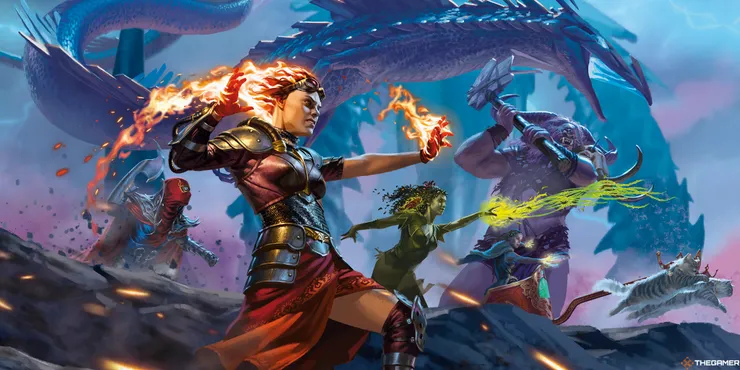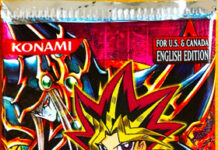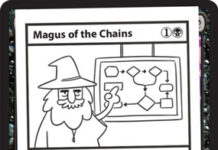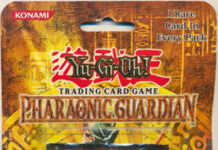Perhaps you clicked the link to this article thinking you knew what to expect, because I’m always making editorial comments about Phyrexia and cutting oneself on the edge, or some such. Perhaps you clicked the link expecting to be outraged; perhaps you didn’t click the link at all, and thus aren’t reading this right now and have no idea how the article starts. If you’re in that last group, you’re missing out on something unusual. Between Phyrexia: All Will Be One‘s release date and when I finished this article, I went and read some of the preview articles on Wizards of the Coast’s site. And more importantly, I actually got some cards from the set, so I’m going to surprise you: I like it.
When I read the previews, I saw an acknowledgment that Phyrexia is very dark and having too much of it around at once might be problematic, and thus the importance of presenting Phyrexian things that can be interesting and entertaining. When I got the cards, I saw what they meant in practice. It turns out there’s a difference using Phyrexia as a setting, and using a Phyrexian conquest as a setting. All Will Be One does the former; New Phyrexia and J. Robert King’s Invasion novels do the latter, and those are the ones that made me have a problem with Phyrexia. In my first ever gameplay-free review – it feels like a different lifetime – I noted that playing with the Scars of Mirrodin block sees you essentially casting war crimes from your hand. The art and concepts from that block are very graphic and seriously test the line of what you can put in a game with a 13+ rating. All Will Be One has clearly learned something from the various Innistrad blocks – those sets are the pinnacle of Magic’s ability to convey horror and fear in a more subtle and sophisticated manner, and there is a clear stylistic parallel.
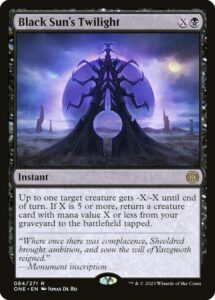 All Will Be One has not abandoned the essence of Phyrexia. It is still a disturbing world characterized by body horror and motivated by alien morality. But the artists and creators found a way to convey that without resorting to “and then the Praetor like totally reaches into the victim’s torso and – isn’t this like totally edgy and mature and cool, bro?” This complaint of mine is visible in New Phyrexia, and even more so in the Invasion novels, and so I made a common mistake in the anticipation phase. Dominaria United‘s storyline rehashed the Invasion block, right down to the Phyrexians having contingency plans for everything the Coalition did even when it made no sense, so I assumed the next set was going in the same direction on other characteristics too.
All Will Be One has not abandoned the essence of Phyrexia. It is still a disturbing world characterized by body horror and motivated by alien morality. But the artists and creators found a way to convey that without resorting to “and then the Praetor like totally reaches into the victim’s torso and – isn’t this like totally edgy and mature and cool, bro?” This complaint of mine is visible in New Phyrexia, and even more so in the Invasion novels, and so I made a common mistake in the anticipation phase. Dominaria United‘s storyline rehashed the Invasion block, right down to the Phyrexians having contingency plans for everything the Coalition did even when it made no sense, so I assumed the next set was going in the same direction on other characteristics too.
There’s an interesting thing about all of the Innistrad sets. They’re full of fantasy creatures like vampires and werewolves, but the art and the cards feel documentary, for lack of a better term. They convey an impression like seeing into a real place that happens to have vampires and werewolves in it, and suggest that the events portrayed are normal (or whatever passes for it in a world like Innistrad). All Will Be One has achieved something arguably even more remarkable: it brings a documentary feel and approach to Phyrexia. The shift I mentioned, from the conquest to the setting, helped them do this; the majority of the cards are relevant to conflict or preparing for conflict, as befits a game themed around planeswalker duels, but their range and their themes are broader. They are much more in line with other sets’ worldbuilding, and with Magic’s idea that you are selecting spells and creatures from various worlds to help achieve your planeswalker goals.
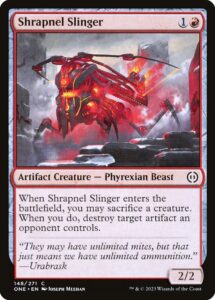
And best of all, the five colors of Phyrexians are back. In hindsight, I probably should have known we would see them again in Phyrexia itself, as you always see the most diverse representatives of a group in its home. But I was impatient, and this was the best thing about the Scars of Mirrodin block; and since Phyrexia is so important to Magic’s lore and history, it needs things like this. Antagonists like Oko or even the Eldrazi are still new enough that they can get by without as much depth. Phyrexia has been around since the very beginning, and it’s right that it grows and evolves along with the rest of the lore.
The black Phyrexians are still mainly an update of Old Phyrexia, but they’ve adopted many of the elements of the old Mephidross society and can’t even unify among themselves, much less with the other colors. They’re perhaps Magic’s only in-depth portrayal of the black-mana attitude to the world taken to its logical extreme, and this helps make up for their Praetor not bringing anything unique to the table in Dominaria United.
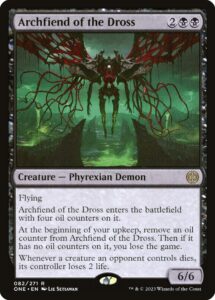
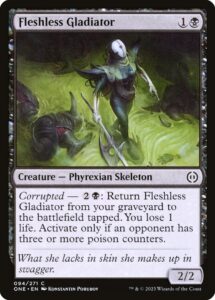
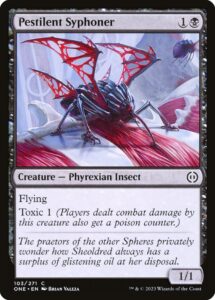
The green Phyrexians have an interesting take on what it means to be both natural life and artificial life at the same time. You might already know that Old Phyrexia’s outermost sphere was mostly seen in the old novels, in which it was a vast expanse that seemed like a jungle, but where everything was actually a Phyrexian creature made of metal. The problem was that the abnormality was overly subtle; the text stated openly that some characters didn’t realize that the animals or trees were constructs until they examined them extremely closely. New Phyrexia’s green creatures are much more openly frightening, as befits one of the less subtle colors, and have an interesting H.R. Giger-esque “nature cyborg” aesthetic, involving elements from humanoids and animals plus explicitly abnormal twists like poison-dripping spines and exhaust vents.
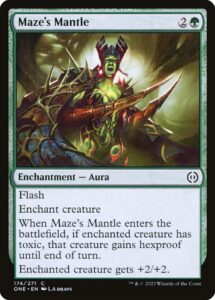
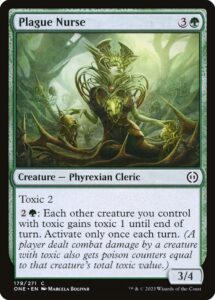
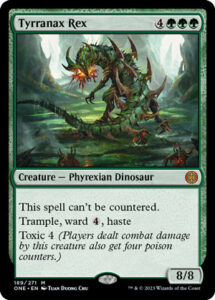
The red Phyrexians are still the most interesting ones to me, and not just because I’m a materials engineer and recognize a lot of their physical characteristics as adaptations to living in a smelter. Recall that they are the ones who have evolved non-Phyrexian emotions – creativity and empathy would be shocking enough, but there’s an art preview from March of the Machine which hints at something even more. (I won’t spoil it for you if you haven’t seen it, but it involves a character from another plane and a twist in their already complex life course.) The current sources point out that Urabrask’s policy is to value diversity and he prefers to compleat people who are willing to join; this juxtaposes nicely with the fact that many of his minions have no faces.

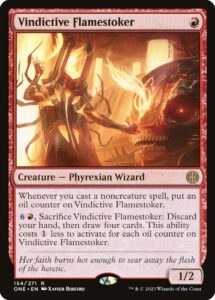
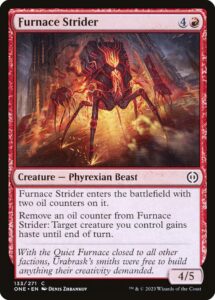
The blue Phyrexians are also a color concept taken to its logical extreme: many of them seem to be walking surgical instruments and laboratory fixtures. Just when you think doctors and hospitals couldn’t get any scarier, someone found a way. They also seem to have taken visual cues from the machine world in the Matrix movies, which helps emphasize that they are an alien intellect with completely divergent goals and morality from humans.
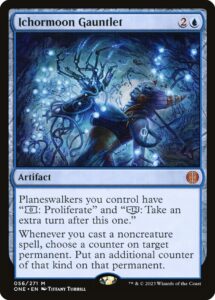
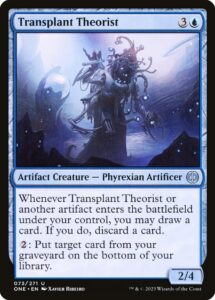
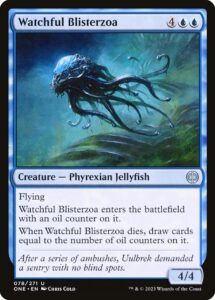
And the white Phyrexians have doubled down on the “twisted religion” concept, with creatures and styles inspired by not just Renaissance art (Elesh Norn’s longstanding style) but obscure Biblical angels like the ophanim. There are creatures in the white section that wouldn’t have looked out of place in Bayonetta, and I do wonder if the art directors explicitly took inspiration from that game. Also, this is a case where the habit of illustrating a card with heavy use of the color of its mana helps. There are All Will Be One white cards with entirely too much white in their illustration – the color’s positive connotations don’t seem so strong when there’s so much of it in the piece that it seems to create glare and almost hurts your eyes.
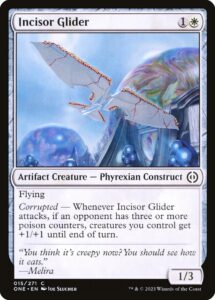
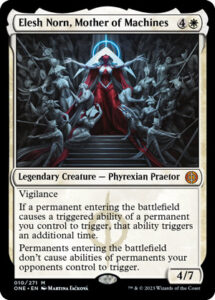
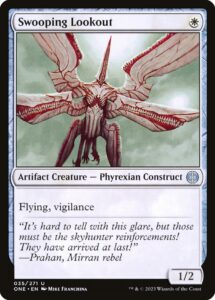
So there’s a lot of good things about All Will Be One – but it also has issues. Some of those good characteristics I’ve listed are the type of thing that makes you ask, “Why don’t they do things like this all the time?” And we have opportunity to ask this in the exact same set, because the compleated planeswalkers are being played largely for shock value – note that some of them were assimilated off-camera and there was little to no development of what it meant to the Gatewatch beyond “you became a Phyrexian without telling me”. To be entirely fair, you have to feel that one or two big conversations are coming in March of the Machine, but there is little reason or progression to the compleations overall, and in some cases none at all. Lukka was the protagonist of Ikoria‘s story, which was slapdash and badly managed, and he’s done basically nothing since; why does it even matter that he’s a Phyrexian now?
Additionally, the ongoing storyline still feels like a mess and there’s no clear way for them to get out of it without annoying a lot of people. To borrow a concept from TV Tropes, Phyrexia has usually been presented as “The Dragon” – not the creature, but an antagonist who must be overcome for the heroes to complete their journey. This is more or less how it has to be for a villain of Phyrexia’s scope and aims. There are compelling stories to be told about villainous victories, but there are no compelling stories to be told about a Phyrexian victory over the entire Multiverse. As I said in my last gameplay-free review, you cannot stretch a survival horror story about resisting the Machine Legion over the next two years of Magic, much less longer. There is simply not enough material. But Wizards of the Coast has failed to tell a compelling story about how Elesh Norn can be defeated.
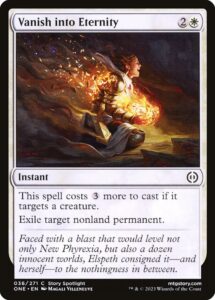
The planeswalkers already couldn’t attack properly because Ajani warned Norn they were coming and she implemented artificial disruptions against planeswalking (which, by the way, there’s little to no precedent for). They didn’t use the Sylex because of the collateral damage it would have caused, due to the interplanar connections created by Realmbreaker. The web stories from New Capenna had some intriguing lines about Elspeth being the one who Elesh Norn fears, but that seems a lot less ominous when we last saw Elspeth on a March of the Machine preview card in the void between worlds, minus her sword. They’ve hinted strongly that Zhalfir is going to return, but Zhalfir wasn’t presented as a major threat to the first Invasion; what’s different about it this time? As I noted above, New Phyrexia’s forces in both Dominaria and the home front had a counter for every single thing the heroes did. That is either carelessness or over-pushing, and it’s well beyond Saturday morning cartoon writing; even Skeletor has consistent character flaws that He-Man and Teela exploit.
As it stands, we’re almost at a point where the heroes’ victory could feel undeserved, the dreaded plot armor accusation; like when you know Roman Reigns is going to win because he’s presented as the top guy by WWE management in their out-of-character content. Or it could feel like the result of blind luck, serendipity, or at best fate, and not the efforts of the heroes. The ending of the Invasion block novels is close to this, with Yawgmoth on the verge of personally destroying Dominaria when Gerrard and Urza suddenly realize how to unleash the true power of the Legacy Weapon (another item that Teferi doesn’t have access to, by the way). A story like Phyrexia’s – which, recall, has run for almost all of Magic’s lifespan – deserves something more interesting.
I’m all for powerful villains. I’m all in on March of the Machine – I love the gallery of heroes approach they seem to have taken, and its “One Last Stand” tagline gets my blood up. But I really need to know what they can pull out to make that one last stand satisfying. I don’t want or need Phyrexia to be defeated permanently; I want Phyrexia to be defeated in a way that makes it, and the victors, equally compelling. Twenty years on from Invasion, I am still waiting to see that. I hope I do not wait in vain.
